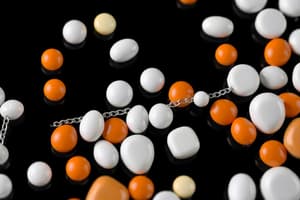Podcast
Questions and Answers
Which type of receptors do preganglionic nerves predominantly bind to in the autonomic nervous system?
Which type of receptors do preganglionic nerves predominantly bind to in the autonomic nervous system?
- Dopaminergic receptors
- Muscarinic receptors
- Neuronal nicotinic receptors (correct)
- Adrenergic receptors
What is primarily regulated by the autonomic nervous system without direct conscious control?
What is primarily regulated by the autonomic nervous system without direct conscious control?
- Heart rate and smooth muscle contraction (correct)
- Voluntary movement
- Sensory processing
- Skeletal muscle contraction
Which statement about the neuromuscular junction (NMJ) is correct?
Which statement about the neuromuscular junction (NMJ) is correct?
- NMJs are involved in both voluntary and involuntary movements.
- NMJs exclusively use adrenergic neurotransmitters.
- Postsynaptic receptors at NMJs are predominantly muscarinic.
- NMJs facilitate voluntary movement through cholinergic transmission. (correct)
In the peripheral nervous system, what characterizes postganglionic nerves?
In the peripheral nervous system, what characterizes postganglionic nerves?
What distinguishes the somatic nervous system from the autonomic nervous system?
What distinguishes the somatic nervous system from the autonomic nervous system?
What is a primary characteristic of the somatic nervous system?
What is a primary characteristic of the somatic nervous system?
Which statement best describes the autonomic nervous system?
Which statement best describes the autonomic nervous system?
What type of neurotransmitter is released at the neuromuscular junction?
What type of neurotransmitter is released at the neuromuscular junction?
Which of the following accurately describes how neurotransmitters operate at synapses?
Which of the following accurately describes how neurotransmitters operate at synapses?
How does the peripheral nervous system interact with the central nervous system?
How does the peripheral nervous system interact with the central nervous system?
What primarily distinguishes the autonomic nervous system from the somatic nervous system?
What primarily distinguishes the autonomic nervous system from the somatic nervous system?
What is a significant outcome of motor neuron transection?
What is a significant outcome of motor neuron transection?
Which aspect of cholinergic transmission is essential for physiological responses?
Which aspect of cholinergic transmission is essential for physiological responses?
What characterizes the sympathetic division of the autonomic nervous system?
What characterizes the sympathetic division of the autonomic nervous system?
What primary neurotransmitter is associated with preganglionic efferents in both the sympathetic and parasympathetic divisions?
What primary neurotransmitter is associated with preganglionic efferents in both the sympathetic and parasympathetic divisions?
What distinguishes parasympathetic ganglia action from sympathetic ganglia action?
What distinguishes parasympathetic ganglia action from sympathetic ganglia action?
Which of the following accurately describes the postganglionic neurons of the parasympathetic nervous system?
Which of the following accurately describes the postganglionic neurons of the parasympathetic nervous system?
How does the adrenal medulla contribute to sympathetic nervous system activation?
How does the adrenal medulla contribute to sympathetic nervous system activation?
What is the main function of cholinergic neurons in the somatic nervous system?
What is the main function of cholinergic neurons in the somatic nervous system?
Which receptor type is activated by acetylcholine at the neuromuscular junction?
Which receptor type is activated by acetylcholine at the neuromuscular junction?
What is a key feature of the reflex arcs in the central nervous system?
What is a key feature of the reflex arcs in the central nervous system?
Flashcards are hidden until you start studying
Study Notes
Nervous System Overview
- Composed of the Central Nervous System (CNS) and Peripheral Nervous System (PNS).
- CNS includes the brain and spinal cord; PNS encompasses everything else.
- PNS is divided into the Somatic and Autonomic nervous systems.
Somatic Nervous System
- Responsible for voluntary movements, respiration, and posture.
- Cell bodies are located within the cerebrospinal axis, leading to spinal efferent nerves.
- Comprised of myelinated nerves; no ganglia, with synapses occurring at the neuromuscular junction (NMJ).
- Drugs can influence functions at NMJ, affecting muscle contractility.
Autonomic Nervous System
- Regulates involuntary functions, controlling cardiac muscle, smooth muscle, and exocrine glands without conscious awareness.
- Composed of two main anatomical divisions: Sympathetic and Parasympathetic.
Sympathetic Nervous System
- Often termed “Thoracolumbar”, with efferents arising from thoracic and lumbar spinal nerves.
- Characterized by short preganglionic neurons and highly interconnected ganglia (22 pairs in the paravertebral chain).
- Adrenal medulla is involved in rapid systemic activation via hormone release.
Parasympathetic Nervous System
- Known as “Craniosacral”, with efferents emerging from cranial nerves III, VII, IX, X, and sacral spinal roots.
- Has ganglia located on or near effector tissues; features slow, deliberate activation of specific targets.
- Less interconnected than sympathetic ganglia.
Efferent Neurons Structure
- Comprises two neurons in series: preganglionic and postganglionic.
- Preganglionic neurons are cholinergic (release acetylcholine) and synapse in ganglia.
- Postganglionic neurons can be either cholinergic or adrenergic, binding to nicotinic (neuronal or muscle) or muscarinic and adrenergic receptors.
Sensory Neurons
- Both Somatic and Autonomic systems receive sensory input via afferent neurons.
- Cell bodies located in ganglia, with dendrites extending to target tissues.
Neurotransmission
- Endocrine system functions slower with hormones traveling through circulation, whereas the nervous system operates rapidly through neurotransmitters at synapses.
- Drugs can modify functions at synaptic sites by mimicking or blocking neurotransmitter effects.
Miscellaneous
- Cholinergic neurons release acetylcholine that binds to nicotinic receptors on postganglionic neurons or muscle fibers.
- Postganglionic parasympathetic neurons primarily use muscarinic acetylcholine receptors to exert their effects on tissues.
Studying That Suits You
Use AI to generate personalized quizzes and flashcards to suit your learning preferences.




